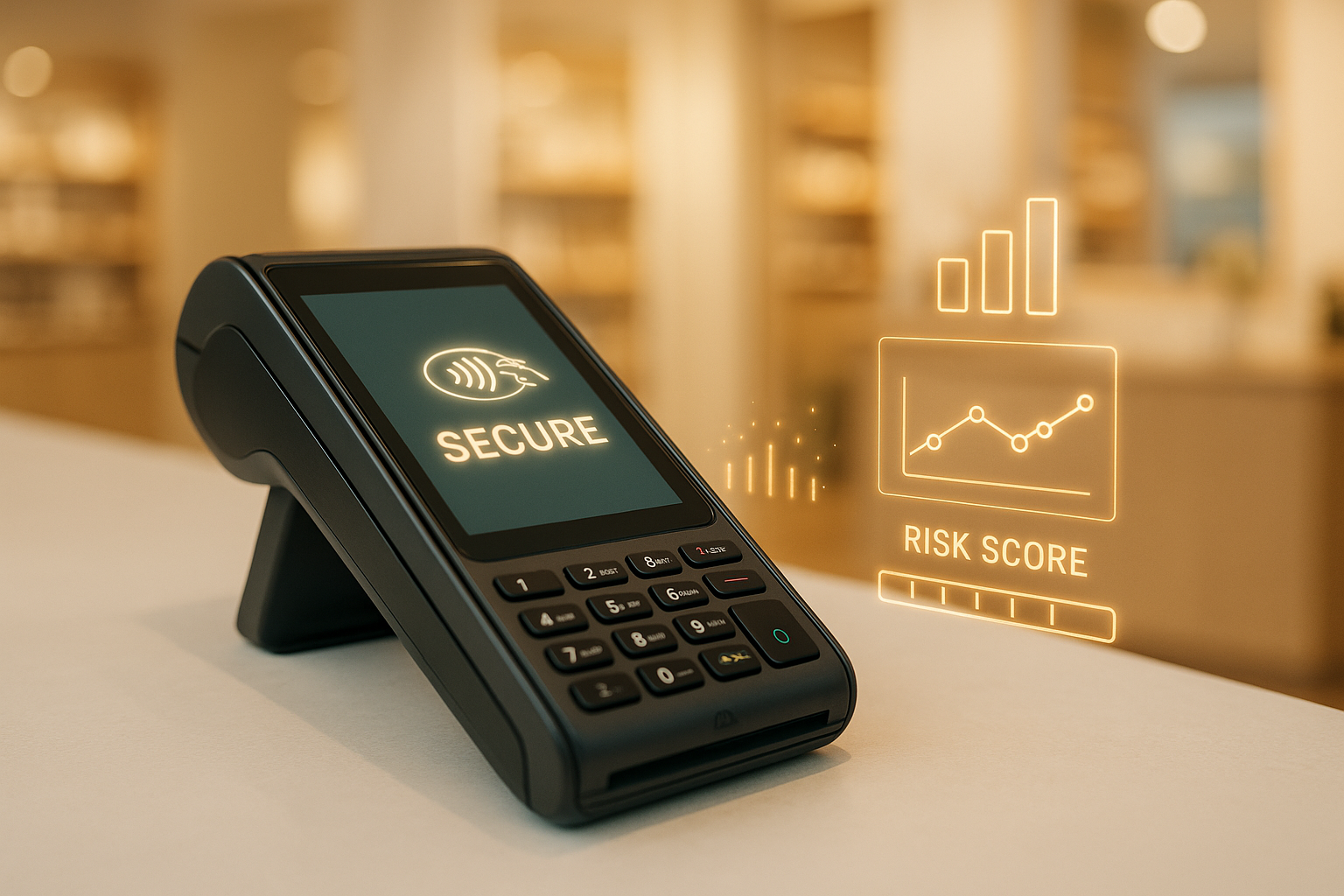Risk scoring in payment processing is a system that assigns a numerical value to transactions to assess their likelihood of fraud. It helps businesses decide whether to approve, review, or decline transactions in real time. Here’s what you need to know:
- What it does: Detects fraud by analyzing data like IP addresses, geolocation, and customer behavior.
- How it works: Uses algorithms and machine learning to calculate risk scores based on transaction data.
- Why it matters: Prevents fraud, reduces chargebacks, and improves customer experience by minimizing unnecessary security checks.
- Key methods: Real-time monitoring for immediate action and batch processing for trend analysis.
Risk scoring protects businesses from financial losses, ensures compliance, and streamlines payment processes while maintaining a secure and smooth experience for customers.
Risk Scoring and Fraud Detection
How Risk Scoring Works
Risk scoring determines the likelihood of fraud in transactions by collecting data, analyzing patterns, and assigning a numerical score. This score helps decide whether to approve, review, or decline a transaction.
Data Points Used in Risk Scoring
Risk scoring systems rely on a variety of data points to evaluate transaction risk. These data points typically fall into the following categories:
- Customer and Transaction Data: Includes details like billing information, contact data, and historical spending habits.
- Digital Identity Markers: Systems analyze IP addresses, browser settings, device configurations, and geolocation data to verify expected behavior. For example, a customer who usually shops from New York, making a purchase from an unfamiliar location, might prompt further review.
- Behavioral Patterns: Unusual deviations from a customer’s typical behavior can indicate potential fraud. Risk scoring evaluates how users interact with websites to detect anomalies.
- External Data Sources: By incorporating external inputs like economic trends, fraud databases, and industry-specific threat intelligence, risk scoring can flag suspicious patterns like abnormal purchase sizes or frequencies.
In specific industries, such as banking, custom models focus on spotting unusual transaction patterns while minimizing disruptions for customers. Meanwhile, online lenders often use these systems to identify inconsistencies in applications and analyze historical financial behavior to create detailed risk profiles.
How Risk Scores Are Calculated
Risk scoring systems use algorithms to turn raw data into actionable scores. These algorithms combine numerical data and qualitative insights to provide a detailed assessment.
Each data point is assigned a weight based on its relevance to fraud detection. For instance, mismatched billing details or suspicious IP addresses carry more weight than less concerning factors. The algorithm then calculates a final score that reflects the likelihood of fraud.
Machine learning plays a key role by refining these calculations over time. If a transaction initially flagged as low-risk later results in a chargeback, the system adjusts its weights to better detect similar patterns in the future. Contextual factors, like comparing a transaction amount to a customer’s usual spending, further improve accuracy and reduce false alarms.
These scores are used to guide both immediate and periodic transaction monitoring.
Real-Time vs. Batch Risk Assessment
Risk scores help determine whether transactions should be monitored in real time or reviewed periodically. Each method has its strengths:
- Real-Time Processing: Transactions are analyzed as they occur, allowing immediate action to block fraud. This method is gaining traction, with 62% of organizations now adopting real-time monitoring for its effectiveness in fraud prevention. Real-time analysis boosts prediction accuracy by 20%, reduces response times by 50%, and cuts credit losses by 15%. For example, a U.S.-based commercial lender used AI-driven real-time analytics to predict customer delinquency with 93% accuracy, significantly lowering loan defaults.
- Batch Processing: This method reviews transactions in bulk at scheduled intervals, such as daily or weekly. It’s cost-efficient for handling large transaction volumes and is ideal for identifying long-term trends and systemic risks.
| Assessment Type | Best For | Key Advantages | Typical Use Cases |
|---|---|---|---|
| Real-Time | High-risk scenarios needing immediate action | Instant fraud detection and prevention | Card-not-present transactions, high-value purchases |
| Batch | Large-scale trend analysis | Cost-effective, long-term pattern detection | Compliance reviews, uncovering long-term fraud schemes |
| Hybrid | Comprehensive fraud prevention | Combines immediate detection with periodic analysis | Multi-layered security, regulatory compliance |
Many businesses choose a hybrid approach, combining real-time monitoring for high-risk events with batch processing for broader trend analysis. This strategy balances cost and effectiveness, with sectors like banking often prioritizing real-time methods to meet strict regulatory demands.
Benefits for Merchants
Risk scoring is changing the game for merchants by offering a smarter way to tackle fraud and optimize payment processes. This approach not only helps protect against fraud but also improves chargeback management and streamlines day-to-day operations.
Early Fraud Detection
Risk scoring works by flagging suspicious transactions through a combination of behavioral analysis, transaction history, device data, and geolocation inconsistencies. This allows merchants to take action as soon as a high-risk score pops up. Fraud scores typically fall within ranges like 0–1,000, 0–100, or 0–10, depending on the platform. These scores are powered by AI and machine learning, which evaluate various risk factors such as flagged emails, risky IP addresses, or stolen credit card details.
For instance, imagine a customer with a flagged email making several high-value purchases in a short time. Such behavior might result in a high-risk score, leading merchants to reject the transaction to avoid potential fraud. This system helps prevent financial losses tied to identity theft, account takeovers, and payment fraud by addressing the issue before it escalates.
Chargeback Prevention
Risk scoring also plays a key role in reducing chargebacks by catching fraudulent transactions before they’re processed. Since excessive chargebacks (typically above 1%) can lead to penalties or even the loss of payment processing privileges, keeping these rates low is crucial for merchants. By analyzing factors like transaction size, frequency, customer history, IP address, and device information in real time, merchants can block high-risk transactions.
This strategy not only saves businesses from the financial strain of chargebacks – including fees, lost goods, and administrative headaches – but also helps preserve their reputation and maintain compliance with payment processors.
Improved Workflow Efficiency
Automated risk scoring boosts efficiency by cutting down on manual reviews and speeding up transaction processing. For example, one financial institution saw a 40% reduction in onboarding time and fewer false positive alerts thanks to its automated risk engine.
"Automated risk scoring, when properly calibrated and tested, enhances both detection effectiveness and resource allocation for compliance teams." – Financial Conduct Authority (FCA)
These systems can also adapt quickly to new regulations or emerging fraud tactics without requiring extensive manual updates. Faster customer onboarding becomes possible through reduced data entry and quicker processing times.
For merchants looking to integrate risk scoring, it’s important to ensure compatibility with existing payment systems, continuously update the scoring models to keep up with evolving fraud methods, and train staff to interpret and act on risk scores effectively. These steps not only improve efficiency but also set the stage for smoother operations and better fraud prevention.
sbb-itb-8c45743
Implementation Best Practices
Integrating a risk scoring system into your operations requires a deliberate approach tailored to your business needs. Here’s how to do it effectively.
Choosing the Right Risk Indicators
Key Risk Indicators (KRIs) act like an early warning system, helping you detect potential fraud before it becomes a problem. These metrics measure and predict risks that could disrupt your business operations or harm your bottom line. The key is to focus on indicators that are measurable, actionable, and closely tied to fraud detection.
When selecting KRIs, prioritize data points that give clear insights into transaction legitimacy. Examples include transaction velocity, geographic inconsistencies, device fingerprinting, and customer behavior patterns. These indicators should align with your company’s specific risk thresholds and be relevant to your operational goals.
For payment processing, it’s important to choose KRIs that are not only measurable but also predictive and easy to compare. Avoid spreading your focus too thin – stick to indicators that provide meaningful insights into your risk profile. Set clear thresholds for each indicator, ensuring they align with your organization’s risk tolerance. Leadership approval is essential before implementing these thresholds, as they need to reflect your broader business objectives.
Once your KRIs are in place, make it a priority to update your models regularly. Fraud tactics evolve quickly, and your system needs to stay one step ahead.
Updating Your Scoring Models
Fraudsters are always adapting, which means your risk models need to keep pace. For instance, in August 2024, FinCEN issued a rule requiring SEC-registered investment advisers to comply with Anti-Money Laundering (AML) requirements by January 1, 2026. This change highlights the importance of having adaptable, risk-based AML programs that can monitor suspicious activities effectively.
To stay current, establish a schedule for reviewing and updating your risk models. High-risk clients may require more frequent reviews to ensure your system remains effective. Incorporate continuous learning systems that adapt to new fraud patterns, and keep customer data updated to maintain compliance.
Ongoing validation of your models is equally important. This includes incorporating regulatory updates, operational feedback, and performance metrics. Collaboration within your industry can also be a valuable tool – sharing information about fraud trends strengthens defenses across the board.
Don’t overlook the human element. Regular staff training ensures your team understands the latest scoring criteria and knows how to respond. When models change, your team needs to be equipped to interpret and act on updated risk scores effectively.
Adding Risk Scoring to Payment Systems
With your indicators refined and models updated, the next step is integrating risk scoring into your payment systems. Start by evaluating your business’s specific risks and selecting a solution that fits your needs and budget.
Use historical transaction data to identify patterns and common fraud trends in your industry. These insights can guide the creation of risk indicators that meet both operational and regulatory requirements. Organize your data carefully, as clean datasets are essential for effective machine learning.
Train your models using this historical data to spot anomalies and define rules that trigger alerts or actions. Tools like APIs and real-time analytics can help integrate your risk scoring system into your existing payment infrastructure without causing delays or disruptions. Additionally, implement verification measures like multi-factor authentication to add another layer of security.
Once your system is in place, monitor its performance closely. Track metrics such as flagged transactions, false positive rates, and fraud detection rates. While AI and machine learning can handle much of the heavy lifting, human analysts should review flagged transactions to ensure legitimate ones aren’t mistakenly blocked.
Finally, invest in regular staff training. Your team should not only understand how the system works but also know when to escalate issues and how to handle flagged transactions with customers. This balanced approach – combining automated efficiency with human judgment – ensures your risk scoring system operates smoothly and effectively.
Pros and Cons of Risk Scoring
Risk scoring, like any business tool, comes with its own set of advantages and challenges. Understanding these trade-offs is essential for making informed decisions about its implementation and use.
Benefits vs. Drawbacks Comparison
The advantages of risk scoring are clear and measurable. One of the biggest benefits is fraud detection and prevention. With global fraud losses expected to surpass $362 billion between 2023 and 2028, the ability to identify and stop fraudulent transactions early is critical.
Another key benefit is reducing chargebacks. By flagging risky transactions before they escalate, businesses can avoid disputes that often lead to costly chargeback fees.
Risk scoring can also improve the customer experience. It allows merchants to minimize unnecessary verification steps for low-risk transactions while applying additional security measures only when needed. This creates a smoother checkout process without compromising safety.
However, risk scoring isn’t without its challenges. False positives are a common issue, where legitimate transactions are mistakenly flagged as risky. This can frustrate customers and lead to abandoned purchases.
The technical complexity of implementing and maintaining these systems can be a hurdle, especially for businesses without dedicated IT teams. Over 60% of operational failures in payment systems result in losses of at least $1 million, underscoring the importance of proper management and maintenance.
Data privacy is another pressing concern. Risk scoring systems analyze large amounts of customer data, making compliance with data protection regulations a priority. Balancing effective fraud detection with privacy concerns is a delicate task.
Here’s a quick look at the trade-offs:
| Advantages | Drawbacks |
|---|---|
| Real-time fraud detection and prevention | False positives flagging legitimate transactions |
| Chargeback reduction | Technical complexity requiring specialized expertise |
| Enhanced customer experience for low-risk users | Data privacy compliance requirements |
| Improved decision-making with data insights | Initial setup costs and ongoing maintenance |
| Competitive edge through better security | Over-reliance on historical data patterns |
Striking the Right Balance
The key to effective risk management lies in balancing the benefits of security with the need for a seamless customer experience. Overly strict security measures can alienate customers, while lenient measures can expose your business to fraud risks. Regular monitoring and fine-tuning of risk parameters are essential to maintaining this balance.
Implementation costs are another consideration. Beyond the initial setup, businesses must allocate resources for system updates, staff training, and performance monitoring. While these costs can be significant, they’re often minimal compared to the potential losses from undetected fraud.
Additionally, there’s a learning curve for your team. Employees need to be trained to interpret risk scores effectively and know when to escalate issues. This ensures that human judgment complements automated systems, leading to better outcomes.
Despite these challenges, many businesses find that the benefits of risk scoring outweigh the drawbacks. Success depends on continuous monitoring, regular updates to scoring models, and finding the right balance between security and customer convenience.
Conclusion
Risk scoring plays a crucial role in safeguarding payment systems while fostering customer trust. It offers clear benefits such as real-time fraud detection, chargeback reduction, and smooth processing for legitimate transactions. With global fraud losses expected to surpass $362 billion between 2023 and 2028, businesses can make smarter decisions about accepting or rejecting orders, protecting both their revenue streams and reputations.
"Risk scoring empowers you to identify fraudulent activities in real time…protecting your hard-earned revenue and maintaining your reputation." – Digicore.
This technology strikes the right balance between security and convenience. Low-risk transactions process without interruptions, while questionable activities are flagged for further review. This approach minimizes false positives and ensures genuine customers enjoy a seamless experience. These advantages highlight why risk scoring is such an integral part of modern payment systems.
To maximize its effectiveness, businesses must focus on continuous updates to scoring models and proper staff training.
Key Takeaways
Risk scoring brings several important benefits to payment processing systems:
- Fraud prevention: Detects and blocks suspicious transactions early.
- Chargeback reduction: Identifies risky orders before they lead to costly disputes.
- Efficiency: Automates processes, cutting down on time and expenses tied to manual reviews.
- Customer confidence: Builds trust by ensuring secure and reliable transaction environments.
- Regulatory alignment: Helps monitor and document suspicious activity to meet compliance requirements.
The key to success lies in thoughtful implementation and ongoing management. Regularly updating models, training staff to interpret scores effectively, and monitoring for new fraud tactics ensure your risk scoring system stays ahead of potential threats. When done right, risk scoring becomes a powerful tool – not just for protecting your business, but also for enhancing the customer experience.
FAQs
How can businesses decide between real-time and batch risk assessment methods?
Businesses have the option to choose between real-time and batch risk assessment methods based on their operational priorities and the risks they face. Real-time assessments are best suited for situations where quick action is critical – think online purchases or high-value transactions where fraud detection and prevention need to happen instantly. In contrast, batch processing is more effective for reviewing large data sets over time, making it easier to spot trends and inform long-term strategies.
Some businesses opt for a hybrid approach, blending the immediacy of real-time assessments with the comprehensive insights offered by batch analysis. This combination helps them respond quickly to urgent risks while also gaining a deeper understanding of overarching patterns. Factors like the volume of transactions, the level of risk involved, and the urgency of intervention should play a key role when deciding which method – or mix of methods – to use.
How can merchants reduce false positives in risk scoring systems while still effectively detecting fraud?
Merchants can cut down on false positives in risk scoring systems by using machine learning algorithms and behavioral analytics. These technologies make it easier to tell genuine transactions apart from fraudulent ones. On top of that, keeping fraud detection rules up to date and leveraging real-time data analysis can sharpen accuracy and reduce unnecessary alerts.
Taking a multi-layered approach to fraud prevention – by blending various tools and techniques – can significantly boost the system’s effectiveness. Automating low-risk alerts and maintaining constant system monitoring helps strike the right balance between catching fraud and ensuring a seamless experience for customers.
How can businesses comply with data privacy laws when using risk scoring systems to process customer data?
To meet data privacy laws when using risk scoring systems, businesses need to align with regulations like the General Data Protection Regulation (GDPR) and the California Consumer Privacy Act (CCPA). These laws focus on key principles such as transparency, collecting only necessary data, and ensuring strong security measures to protect customer information.
Some essential practices include running regular risk assessments, applying strong encryption methods like SSL/TLS, and establishing clear, well-documented policies for handling and processing data. By sticking to these guidelines, businesses can protect customer information, minimize legal exposure, and strengthen trust in their payment systems.




